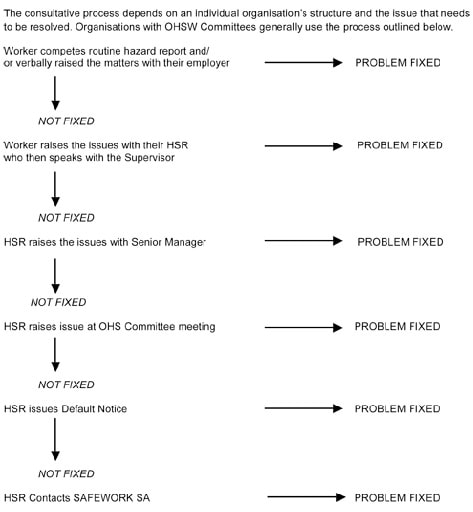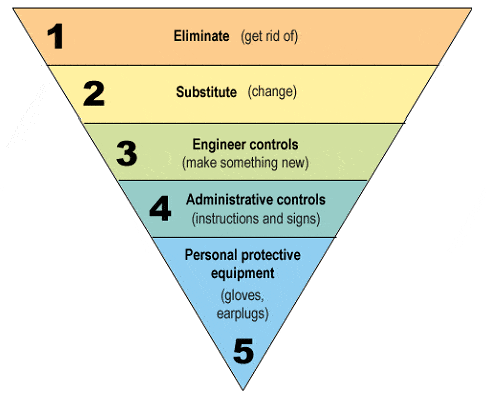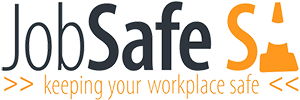Consultation Process
The consultative process depends on an individual organisations structure and the issue that needs to be resolved. Organisations with H&S Committees generally use the process outlined below, but must be a negotiated process and policy. (If not a process, policy in place WHS Act & WHS Regulations for Issue Resolution applies.)

RISK ASSESSMENT CALCULATOR (Example)

Hierarchy of Control-
1-Eliminate the hazard
Options which get rid of the hazard altogether
The best way to eliminate the risk is to completely remove the hazard
For Example;
- The need for excessive photocopying and collation can be eliminated if material is circulated by electronic mail
- Repair damaged equipment promptly
- Ensure new equipment meets the ergonomic needs of the ˜users
- Move a noisy machine from a quiet area
2-Substitution
Replacing a hazardous substance or work practice with a less hazardous one.
For Example:
- A telephone handset can be replaced with a head set where there is constant use of the telephone
- Substituting a smaller package or container to reduce the risk of manual handling injuries such as back strain
- Substituting a hazardous chemical with a less dangerous one
3-Isolation & Engineering Controls
The provision of mechanical aids, barriers, machine guarding, ventilation or insulation to isolate a hazard from employees.
For example;
- Electrical cut out switches
- Roll over frames on vehicles
- Duress alarms or mechanical screens to separate workers from violent or physically aggressive clients
- Isolating copying equipment in soundproof and ventilated rooms
- Using anti-glare screens on computers
- Using trolleys or mechanical lifting aids
- Changing bench heights to reduce bending
Establishing policies, procedures and work practices designed to reduce a workers exposure to a risk. It can also include the provision of specific training and supervision.
4-Administrative Controls
For example:
- Providing alternative tasks for workers so as to prevent continuous keyboard work for long periods.
- Increasing job variety and introducing job rotation
- Redesigning jobs
- Regularly maintaining plant and equipment
- Training and education to learn how to-
- – identify and assess risks
– use methods of control
– know and apply the legislative requirements
– safely use mechanical aids and equipment
5-Personal Protective Equipment (PPE)
Covering and protecting a workers body from hazards. It can be used as a short-term control measure until a higher order control has been provided, or to supplement it. PPE must be provided and maintained by the employer.
The employer would also have to provide training for workers required to use it, and the employee would have a responsibility to use it properly.
Some examples of PPE are:
– Ear plugs in noisy areas
– Eye protection when working with chemicals
– Gloves to protect against infection
NOTE: Personal Protective Equipment is a last resort.

Workplace Bullying is also a Hazard!!!!
An employee’s step-by-step guide to dealing with workplace bullying
1) Recognise the signs
– are you being intimidated, threatened or isolated?
– is your work performance always being picked on unfairly or unreasonably?
– are you being humiliated in front of other workers?
– are you being threatened with dismissal?
– are these incidents continuous and persistent?
2) Do not worry about why it is happening
– it is against the law to continuously bully and harass a worker.
3) Clearly identify the bully or bullies
– make sure you know exactly who is doing the bullying.
– is there a ringleader?
– who has the power?
4) Keep records
– keep a diary or notes of bullying incidents, when and where it happened, who was responsible, how you felt, potential witnesses etc.
– notes are important to demonstrate a pattern of events.
– it is important to have records if you are making a claim for compensation.
5) Talk about it
– discuss the problem with other workers, health and safety representatives and union officials.
6) Do not retaliate
– do not become a bully yourself or use physical violence or you may be seen to be no better than the bullies themselves.
7) Stay where you are
– do not resign or seek a transfer, as this would be letting the bully win.
– you need to address the problem with your network of support in your work environment.
8 ) Make a formal complaint
– if you are making a formal complaint it needs to be in writing (always keep a copy).
– make sure your formal complaint shows a consistent pattern of mistreatment and that you use the correct procedure (get help if not sure).
9) If your management does not help you
There are other organisations which can help you, such as:
– The Equal Opportunity Commission
– The office of the Employee Ombudsman
– Workplace Services
– Safework SA
